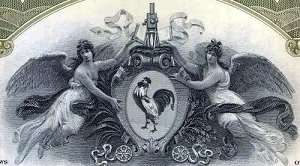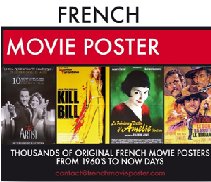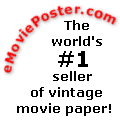Pathe Company opened in New York
in 1904 as a subsidiary of PatheFreres (Bros.) in France and boasted
a catalogue of 12,000 titles.
With the demand for new films at
a frenzy, Pathe was the first to utilize multiple productions
and very rapidly became the dominant production company in the
world. While major US studios were producing 1 or 2 films a month,
Pathe was releasing 5 to 7 per week.
In an attempt to keep up, US studios
were duplicating Pathe films at a dizzying rate and releasing
them as their own. Edwin Porter, in a later interview, admitted
that his first job with Edison was copying French films.
Between 1905-1908 Pathe accounted
for about 1/3 of all films shown in the US.
In 1909, Pathe was
asked to join Edison in forming the Motion Picture Patents Company
to try to shut out smaller studios. The MPPC was formed by Edison,
Biograph, Essanay,
Kalem, Kleine,
Lubin, Melies,
Pathe, Selig and Vitagraph.
This formation basically set the standards for movie paper.
For distribution,
the MPPC created the General Film Company, which Pathe used for
distribution in the US.
In 1911, Pathe issued
Pathe Weekly which was the first US wide newsreel. The newsreel
soon caused problems with several other companies
WWI was taking it's
toll on the company, so the Pathe Bros moved their headquarters
to the US and created the Pathe-Eclectic Company in 1913.
When Randolph Hearst
approached Pathe wanting to get into the film industry, Pathe
did a joint production with hearst, called Perils of Pauline.
This 20 episode serial was released through both General Film
and Pathe's new Eclectic Company distribution.
Pathe stopped all
production in the US in 1914 and in
1915 changed the name of Pathe Company to Pathe Exchange, Inc.
After WWI, the Pathe
Bros. moved back to France and divided the company.

logo from stock certificate issued in 1930 before
the merger
In 1923, Pathe Exchange sold
for 26 million Francs and came under the control of Merrill Lynch and the
name changed to American Pathe
In 1927, American Pathe was acquired
by the Orpheum Circuit to help supply films to the K-A-O theater chain and
with Cecil B. DeMille's Producers Distributing Corp.
In 1928, the merger of Orpheum Circuit Inc, including
the Keith-Albee-Orpheum (KAO) theater chains and their subsidiary American
Pathe and DeMille's Producers Distributing Corp (PDC), FBO studios, and Radio
Corporation of America's Photophone division became RKO Pictures.
However, American Pathe was divided off in the
merger with Joe Kennedy relinquishing his FBO studios and getting ownership
of American Pathe. Kennedy moved American Pathe into DeMille's Culver City
studio and started production. However, Kennedy became disgruntled and sold
Pathe and the Culver City studio to RKO on Jan. 29, 1931 (with their productions
being released as RKO Pathe).
In 1932, Pathe was moved to producing newsreels
and documentaries only. Production continued at Culver City until 1937 when
David O. Selznick approached RKO for a long term lease of the Culver City
studios (where he began production on Gone With the Wind).
In 1941, American Pathe acquired Producers Releasing
Corp. which was headed by Sigmund Neufeld. However, they were sold off in
a merger in 1947 with Eagle-Lion.
Pathe primarily used Acme Litho to produce their
US posters during the early years but changed to Morgan in the
late teens..





